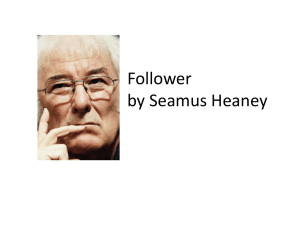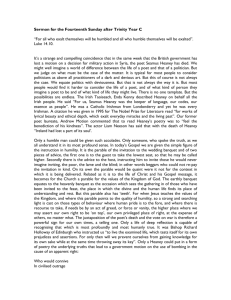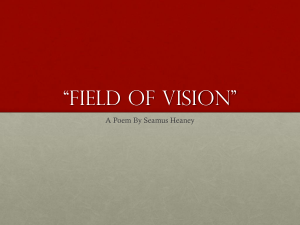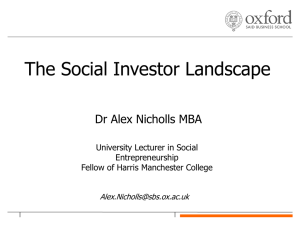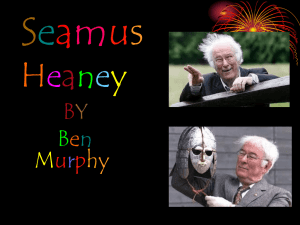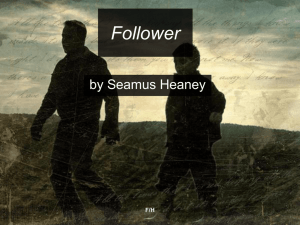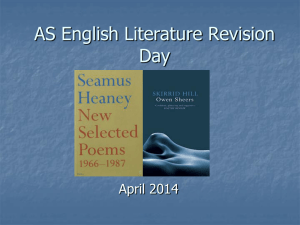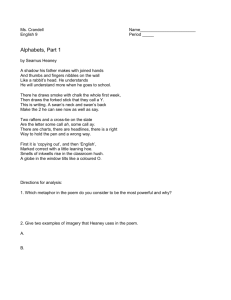Unit 3 Literature - Swinburne Senior Secondary College
advertisement
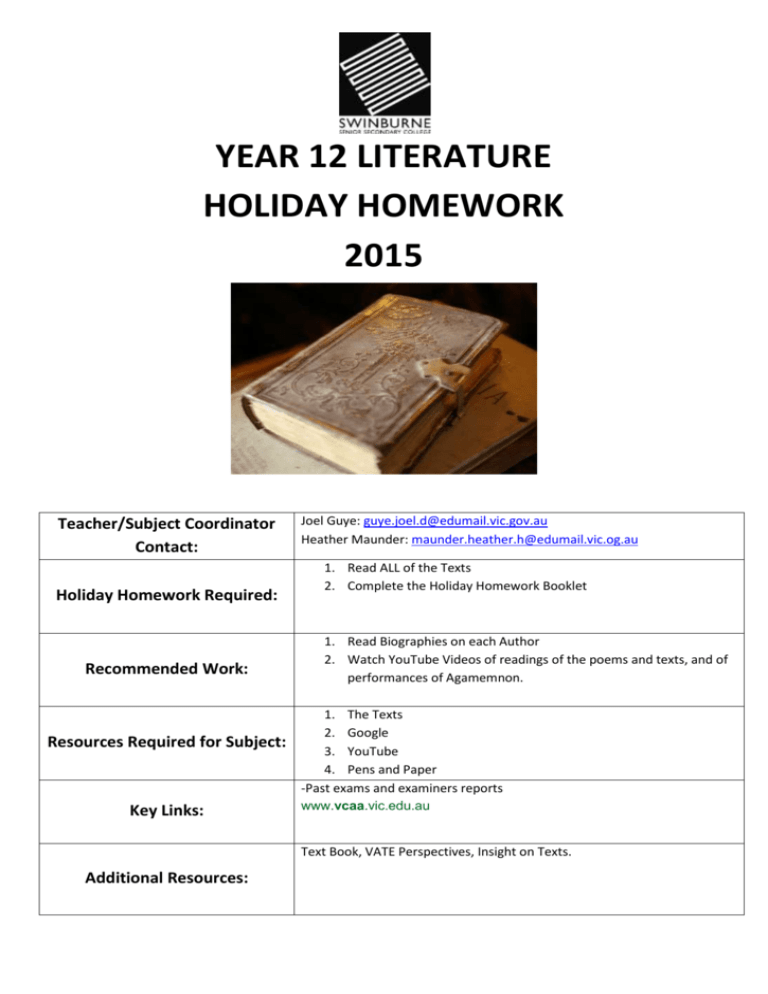
YEAR 12 LITERATURE HOLIDAY HOMEWORK 2015 Teacher/Subject Coordinator Contact: Holiday Homework Required: Recommended Work: Resources Required for Subject: Key Links: Joel Guye: guye.joel.d@edumail.vic.gov.au Heather Maunder: maunder.heather.h@edumail.vic.og.au 1. Read ALL of the Texts 2. Complete the Holiday Homework Booklet 1. Read Biographies on each Author 2. Watch YouTube Videos of readings of the poems and texts, and of performances of Agamemnon. 1. The Texts 2. Google 3. YouTube 4. Pens and Paper -Past exams and examiners reports www.vcaa.vic.edu.au Text Book, VATE Perspectives, Insight on Texts. Additional Resources: Unit 3: Year 12 English SWINBURNE SENIOR SECONDARY COLLEGE LITERATURE UNITS 3 & 4 2015 Literature is an ideal subject for students who like to read, listen to and watch a range of texts. The study of literature focuses on the enjoyment and appreciation of reading that arises from discussion, debate and the challenge of exploring the meanings of literary texts. Students reflect on their interpretations and those of others. Students learn to understand that texts are constructions, to consider the complexity of language and to recognise the influence of contexts and form. The study of literature encourages independent and critical thinking in students’ analytical and creative responses to texts, which will assist them in the workforce and in future academic study. There are no prerequisites for Units 3 & 4 Literature; however they are studied as a sequence. Students may study Literature and English, or they may study Literature as their designated English. UNIT 3 This unit focuses on the ways writers construct their work and how meaning is created for and by the reader. Students consider how the form of a text affects meaning and creates expectations in readers. They consider the ways texts represent views and values and comment on human experience, and the social, historical and cultural contexts of literary works. Area of study 1 Adaptations and transformations Students recognise the major divisions of poetry, drama and prose and how these forms can be divided into genres such as crime, science fiction, fantasy and romance. They look at the features of a particular form of text, and how its conventions are used, to reflect on the way meaning changes when the form of a text is changed. For example, students may explore the transformation of prose into film, poetry into performance, or script into stage performance or film. Area of study 2 Views, values and contexts In this area of study students consider how views and values are expressed in texts to create particular perspectives of the world. They look at the issues, ideas and contexts writers choose to explore and how these may be shaped by and reflect the cultural, social, historical or ideological contexts in which they were created. Students investigate the ways readers may arrive at different interpretations of a text; they justify their own interpretation through close attention to ideas, incidents, characters and images. Area of study 3 Considering alternative viewpoints Students engage with the viewpoints of others, for example, in a review, critical essay or commentary. They explore the underlying values and assumptions of these viewpoints. For example, they consider what is questioned by the text, in its representation of gender or culture. They show how the content is shaped and structured, and how they are positioned by the writer’s choice of language. Students construct their own reading of a text and compare it with other interpretations. UNIT 4 This unit focuses on students creative and critical responses to texts. They consider the context of their responses as well as the concerns, the style of the language and the point of view in their recreated or adapted work. They develop an interpretation of a text and learn to synthesise the insights gained from their engagement with various aspects of a text. Area of study 1 Creative responses to texts In composing their own responses, students show both how writers develop images of people and places, and an understanding of language, voice, form and structure. In their adaptation of the tone and style of the text students show an understanding of the concerns and attitudes of the text. They reflect critically on aspects of the text on which they based their own writing, and discuss the purpose and context of their response. Area of study 2 Close analysis This area of study focuses on detailed scrutiny of the style, concerns and construction of a text. Students examine the ways specific features or moments in the text contribute to their overall interpretations; features such as structure, context, genre, imagery, rhythm, irony, voice, setting, stage directions, dialogue, characterisation and mood. Assessment The student’s level of achievement for will be determined by school assessed coursework and an end-ofyear examination. School assessed coursework for Unit 3 will contribute 25 percent to the study score. School assessed coursework for Unit 4 will contribute 25 percent to the study score. The level of achievement for Units 3 & 4 is also assessed by an end-of-year examination which will contribute 50 percent to the study score. TEXT LIST 2015 Literature for Senior Students Robert Beardwood List A Mary and Max Peter Elliot The Turn of the Screw Henry James List B* Agamemnon Aeschylus Jane Eyre Charlotte Bronte Collected Stories Peter Carey Opened Ground Seamus Heaney * These four texts are examination texts. List A texts are assessed by coursework only. Unit 3 Literature Semester 1 2015 WEEK 1 Orientation Class content Mary and Max (Film Screening) Skills Homework & Assessment Homework due at or before the beginning of class Holiday HW due Jan 28- Jan 30 2 Mary and Max Mary and Max Feb 2 - 6 3 Mary and Max Mary and Max Feb 9 - 13 4 Turn of the Screw Turn of the Screw Learning Task 1 – Heaney Poem Turn of the Screw Turn of the Screw Learning Task 2 – Heaney Poem Turn of the Screw Turn of the Screw: Practice SAC Learning Task 3 – Heaney Poem Turn of the Screw Turn of the Screw SAC Learning Task 4 – Heaney Poem Turn of the Screw SAC Jane Eyre Jane Eyre Learning Task 5 – Heaney Poem Jane Eyre Jane Eyre Learning Task 6 – Heaney Poem Jane Eyre Jane Eyre Holiday HW due Learning Task 7 – Carey Story Jane Eyre Jane Eyre: Practice SAC Learning Task 8 – Carey Story Jane Eyre Jane Eyre: SAC Learning Task 9 – Carey Story 1st - Jane Eyre Views and Values Practice SAC Jane Eyre (Film Screening) Jane Eyre Learning Task 10 – Carey Story Jane Eyre Jane Eyre: Practice SAC Learning Task 11 – Carey Story Jane Eyre Jane Eyre: Adaptations SAC Learning Task 12 – Carey Story 22nd Adaptations SAC Peter Carey Short Stories Peter Carey Short Stories Learning Task 13 – Carey Story Peter Carey Short Stories Carey and Jane Eyre Exam Prep End Unit 3: all work due Feb 16 - 20 5 Feb 23 - 27 6 Mar 2 - 6 7Labour day Mar 9 - 13 8 Mar 16 - 20 9 Mar 23 - 27 HOLIDAY 10 April 13 - 17 11 Anzac day April 20 - 24 12 April 27 - May 1 13 May 4 - 8 14 May 11 - 15 15 May 18 - 22 16 May 25 - 29 17 June 1 - 5 GAT week Englishes practice exam Queen’s birthday June 8 - 12 June 15 - 19 Semester Two Jun 22 - 26 Unit 4 Literature Semester 2 2015 WEEK Class content 1 Peter Carey Short Stories June 15 – 19 Peter Carey Short Stories 2 Peter Carey Short Stories June 22 – 26 Peter Carey Short Stories HOLIDAY 3 Skills Homework & Assessment Homework due at or before the beginning of class Peter Carey Short Stories Holiday HW Due July 13 – 17 Creative Response Planning Learning Task 1 – Heaney Poem 4 Creative Response: Session 2 Learning Task 2 – Heaney Poem July 22 – 24 Creative Response: Session 3 5 Creative Repsonse: Session 4 (SAC and Reflective Commentary Due) Soire Learning Task 3 – Heaney Poem 31st Creative Response SAC and Reflective Commentary 6 Agamemnon Learning Task 4 – Heaney Poem Aug 3 – 7 Agamemnon 7 Agamemnon Aug 10 – 14 Agamemnon 8 Agamemnon Aug 17 – 21 Agamemnon: Practice SAC 9 Seamus Heaney Poetry Aug 24 – 28 Seamus Heaney Poetry 10 Seamus Heaney Poetry Aug 31 – Sep 4 Seamus Heaney Poetry 11 Seamus Heaney: Practice SAC Sep 7 - 11 Passage Analysis Revision 12 Passage Analysis SAC: Agamemnon or Heaney 14th – Passage Analysis SAC Exam preparation Holiday HW due July 27 - 31 Learning Task 5 – Heaney Poem Learning Task 6 – Heaney Poem Sep 14 – 18 HOLIDAY 13 Oct 5 – 9 14 Exam preparation Oct 12 – 16 15 Exam preparation Oct 19 – 23 End unit 4: End Unit 4: all work due 16 Oct 26 – 30 17 Cup Day Nov 2 – 6 18 Nov 9 – 13 Exam: Mary and Max Adam Elliot How do the stills from Mary and Max above help to characterise the two main characters of the film? What do they tell us about them and their relationship. In your response you should comment on: - Elliot’s use of colour (or lack of) and contrast - The characters’ facial expressions, body-type, costume, props. - Elliot’s use of lighting and the ways in which the shots are framed - How the settings contribute to the characterisations “Pen Pals” Write a letter to an imaginary person on the other side of the world. You have never met them. The narrator of your letter should explore themes of isolation, loneliness and a longing to be accepted in society. You should work to do this subtly and the themes should be apparent in the tone and style of your writing as well as in the content you describe. How would you describe Australia to them? What aspects of life in Australia would you like them to know about? Why is your character writing the letter? Jane Eyre Reading Questions 1.In Jane Eyre, nothing can better show a man's moral worth than the way in which he treats the women in his life. How is Rochester's character reflected in the way he treats Jane, Adele, Bertha Mason, and Miss Ingram, and in his reported treatment of Celine Varens? How is St. John's character reflected in the way he treats Jane, Miss Oliver, and Diana and Mary? Why does this serve as such a good gauge of a man's morality and worth? What other relationships serve similar functions in the novel? 2. Throughout the novel, questions of identity are raised. From her identity as an orphan and stranger in the hostile environment of Gateshead Hall to that of a ward of the church at Lowood; from her being a possible wife of Rochester, then of St. John, to being the cousin of Diana and Mary, Jane is constantly in transition. Trace these changes in identity and how they affect Jane's view of herself and the world around her. Describe the final discovery of her identity that becomes apparent in the last chapter of the novel and the events that made that discovery possible. 3. Throughout the novel, Charlotte Brontë uses biblical quotes and religious references. From the church-supported school she attended that was run by Mr. Brocklehurst to the offer of marriage she receives from St. John, she is surrounded by aspects of Christianity. How does this influence her throughout her development? How do her views of God and Christianity change from her days as a young girl to the end of the novel? How is religion depicted in the novel, positively or negatively? 4. Many readers of Jane Eyre feel that the story is composed of two distinct parts, different in tone and purpose. The first part (chapters 1-11) concerns her childhood at Gateshead and her life at Lowood; the second part is the remainder of the story. Is creating such a division justified? Is there a genuine difference of tone and purpose between the two sections as they have been described? Some critics and readers have suggested that the first part of Jane Eyre is more arresting because it is more directly autobiographical. Do you find this to be true? 5. Scenes of madness and insanity are among the most important plot devices in Jane Eyre. From the vision Jane sees when locked in the bedroom at Gateshead to her hearing the "goblin laughter" she attributes to Grace Poole, to the insanity and wretchedness of Bertha Mason, madness is of central importance to the plot and direction of the story. Give examples of madness in the text, and show how they affect the reader's understanding of the character experiencing the madness and how these examples affect the reader's understanding of the characters witnessing it. 6. There is probably no single line in the whole of Jane Eyre that has, in itself, attracted as much critical attention as the first line of the last chapter: "Reader, I married him." Why is the phrasing of this line so important? How would the sense be different-for the sentence and for the novel as a whole-if the line read, "Reader, we were married"? Please respond to these questions once you have read the novel on the following pages of lined paper. Collected Stories Peter Carey Peter Carey was born in Australia in 1943. He claims his birthplace of Bacchus Marsh had a population of 4,000. This fact should probably be checked. He was educated at the local state school until the age of eleven and then became a boarder at Geelong Grammar School. He was a student there between 1954 and 1960 — after Rupert Murdoch had graduated and before Prince Charles arrived. In 1961 he studied science for a single unsuccessful year at Monash University. He was then employed by an advertising agency where he began to receive his literary education, meeting Faulkner, Joyce, Kerouac and other writers he had previously been unaware of. He was nineteen. For the next thirteen years he wrote fiction at night and weekends, working in many advertising agencies in Melbourne, London and Sydney. After four novels had been written and rejected The Fat Man in History — a short story collection — was published in 1974. This slim book made him an overnight success. From 1976 Carey worked one week a month for Grey Advertising, then, in 1981 he established a small business where his generous partner required him to work only two afternoons a week. Thus between 1976 and 1990, he was able to pursue literature obsessively. It was during this period that he wrote War Crimes, Bliss, Illywhacker, Oscar and Lucinda. Illywhacker was short listed for the Booker Prize. Oscar and Lucinda won it. Uncomfortable with this success he began work on The Tax Inspector. In 1990 he moved to New York where he completed The Tax Inspector. He taught at NYU one night a week. Later he would have similar jobs at Princeton, The New School and Barnard College. During these years he wrote The Unusual Life of Tristan Smith, Jack Maggs, and True History of the Kelly Gang for which he won his second Booker Prize. In 2003 he joined Hunter College as the Director of the MFA Program in Creative Writing. Since then he has published five novels: My Life as a Fake, Theft, His Illegal Self, The Chemistry of Tears, and Parrot and Olivier in America (which was a finalist for both the U.S National Book Award and the Man Booker Prize.) He is at work on a new novel. Stories for study: ‘Do You Love Me?’ ‘Life & Death in the South Side Pavilion’ ‘Room No. 5 (Escribo)’ ‘Peeling’ ‘A Windmill in the West’ ‘Concerning the Greek Tyrant’ ‘Conversations with Unicorns’ ‘American Dreams’ ‘The Fat Man in History’ ‘A Schoolboy Prank’ ‘The Chance’ ‘He Found Her in Late Summer’ Which one is your favourite and why? (petercareybooks.com/life/) “American Dreams” Read the story and answer the following questions on the following lined pages. 1. List icons of life in an Australian country town. 2. On what evidence does the narrator base his belief that the townspeople treat their town with 3. 4. 5. 6. 7. 8. 9. contempt? What are ‘American Dreams’? How did the townspeople react when Mr Gleason started to build the wall on Bald Hill? Outline the narrator’s and his father’s different theories about why Mr Gleason built the model town. What is your theory? “…when I finally knew what I was seeing I felt such an incredible mixture of jealousy and guilt and wonder that I didn’t know what to do with the roof.” Explain. Why did they decide to destroy the model town, and what stopped them? The town attracted many American tourists. Why? As the years passed, The Americans were disappointed, the town grew wealthy and the narrator guilty. Explain the irony. What comment is Carey making about tourism? About Australians? Creative response – choose one topic: Write an account of one of the transgressions against Mr Gleason Write a letter home to America from one of the tourists Write an internal monologue for Mrs Gleason that explores one of the gaps in the story Write three entries from Mr Gleason’s diary Set this story in the 21st century American Dreams Questions: Creative Response: The Turn of the Screw Henry James An American novelist and naturalized Englishman, Henry James was an important figure in transatlantic literary culture of the day. Born on April 15, 1843, in New York City, Henry James became one of his generation's most wellknown writers and remains so to this day for such works as The Portrait of a Lady and The Turn of the Screw. Having lived in England for 40 years, James became a British subject in 1915, the year before his death. He died on February 28, 1916, in London, England. The Turn of the Screw, originally published in 1898, is a ghost story novella]. Due to its ambiguous content, it became a favourite text of academics who subscribe to New Criticism. The novella has had differing interpretations, often mutually exclusive. Many critics have tried to determine the exact nature of the evil hinted at by the story. However, others have argued that the true brilliance of the novella comes with its ability to create an intimate confusion and suspense for the reader. 1. Add three interesting facts and/or pieces of gossip to the author’s profile: 2. Read the novella, then complete the following: One word review: …………………………………. What is your interpretation of the evil hinted at by the story. Justify your evaluation, supporting it with evidence: Do the quiz on the novella at www.sparknotes.com/lit/screw/quiz/html. Submit your answers. Write your score : …………….. Imagine you are producing and directing a film adaptation of The Turn of the Screw. Cast it, and find a location/s where you will shoot the film. Seamus Heaney Biography Academic, Educator, Poet, Journalist (1939–2013) “The poet understands he has a veteran's understanding that the world is not quite trustworthy, and that we most be grateful for it when it is trustworthy.” —Seamus Heaney Synopsis Born in County Londonderry, Northern Ireland, on April 13, 1939, Seamus Heaney published his first poetry book in 1966, Death of a Naturalist, creating vivid portraits of rural life. Later work looked at his homeland's civil war, and he won the 1995 Nobel Prize in Literature for his globally acclaimed oeuvre, with its focus on love, nature and memory. A professor and speaker, Heaney died on August 30, 2013. Background and Early Career Seamus Justin Heaney was born on April 13, 1939, on a farm in the Castledàwson, County Londonderry region of Northern Ireland, the first of nine children in a Catholic family. He received a scholarship to attend the boarding school St. Columb's College in Derry and went on to Queens University in Belfast, studying English and graduating in 1961. Heaney worked as a schoolteacher for a time before becoming a college lecturer and eventually working as a freelance scribe by the early '70s. In 1965, he married Marie Devlin, a fellow writer who would figure prominently in Heaney's work. The couple went on to have three children. Acclaimed Poet Seamus Heaney had his poetry collection debut in 1966 with Death of a Naturalist, and went on to publish many more lauded books of poems that included North (1974), Station Island (1984), The Spirit Level (1996) andDistrict and Circle (2006). Over the years, he also became known for his prose writing and work as an editor, as well as serving as a professor at Harvard and Oxford universities. Nature, Love and Memory Heaney's work is often a paean to the beauty and depth of nature, and he achieved great popularity among both general readers and the literary establishment, garnering a massive following in the United Kingdom. He wrote eloquently about love, mythology, memory (particularly on his own rural upbringing) and various forms of human relationships. Heaney also provided commentary on the sectarian civil war, known as the Troubles, which had beset Northern Ireland in works such as "Whatever You Say, Say Nothing." Heaney was later applauded for his translation of the epic poem Beowulf(2000), a global best-seller for which he won the Whitbread Prize. He had also crafted translations of Laments, by Jan Kochanowski, Sophocles'sPhiloctetes and Robert Henryson's The Testament of Cresseid & Seven Fables. Wins Nobel Prize Heaney was awarded the Nobel Prize in Literature in 1995 and later received England's T.S. Eliot and David Cohen prizes, among a wide array of accolades. He was known for his speaking engagements as well, and, as such, traveled across the world to share his art and ideas. Heaney published his last book of poetry, Human Chain, in 2010. Regarded as a kind, lovely soul, he died in Dublin, Ireland, on August 30, 2013, at the age of 74. Digging BY SEAMUS HEANEY Between my finger and my thumb The squat pen rests; snug as a gun. Under my window, a clean rasping sound When the spade sinks into gravelly ground: My father, digging. I look down Till his straining rump among the flowerbeds Bends low, comes up twenty years away Stooping in rhythm through potato drills Where he was digging. The coarse boot nestled on the lug, the shaft Against the inside knee was levered firmly. He rooted out tall tops, buried the bright edge deep To scatter new potatoes that we picked, Loving their cool hardness in our hands. By God, the old man could handle a spade. Just like his old man. My grandfather cut more turf in a day Than any other man on Toner’s bog. Once I carried him milk in a bottle Corked sloppily with paper. He straightened up To drink it, then fell to right away Nicking and slicing neatly, heaving sods Over his shoulder, going down and down For the good turf. Digging. The cold smell of potato mould, the squelch and slap Of soggy peat, the curt cuts of an edge Through living roots awaken in my head. But I’ve no spade to follow men like them. Between my finger and my thumb The squat pen rests. I’ll dig with it. Analysing Poetry: Heaney’s Digging Key aspects/questions What is the poem about? What is the significance of the title? What are the key ideas and concerns of the poem? What is Heaney’s view of these? What is the setting of the poem? Is it significant? Who is the narrator? What effect does this have on the poem’s message. Does the poem have a particular structure and/or rhyming scheme? If so what does it contribute to the meaning of the poem? How would you describe the language of the poem? What does this add to the meaning? What does the poem reveal about the narrator/author/audience? Description Key Images/phrases/words AGAMEMNON From The Oresteia by Aeschylus The events of Agamemnon take place against a backdrop that would have been familiar to an Athenian audience. Agamemnon is returning from his victory at Troy, which has been besieged for ten years by Greek armies attempting to recover Helen, Agamemnon's brother's wife, who was stolen by the treacherous Trojan Prince, Paris. (The events of the Trojan War are recounted in Homer's Iliad.) The tragedies of the play occur as a result of the crimes committed by Agamemnon's family. His father, Atreus, boiled the children of his own brother, Thyestes, and served them to him. Clytemnestra's lover, Aegisthus (Thyestes's only surviving son), seeks revenge for that crime. Moreover, Agamemnon sacrifices his daughter, Iphigenia, to gain a favourable wind to Troy, and Clytemnestra murders him to avenge her death. The weight of history and heritage becomes a major theme of the play, and indeed the entire trilogy, for the family it depicts cannot escape the cursed cycle of bloodshed propagated by its past. (Sparknotes) Agamemnon:” The gods made me sacrifice Iphigenia to ensure safe passage for the Greek fleet so that I could retrieve my brother’s wife Helen from Troy. I owed a blood debt to my brother Menelaus. I sacked Troy, killed the king and return with Troy’s gold and Cassandra as my slave. I long to see my country and my wife”. Clytemnestra: “I ruled Argos for ten years, keeping order while Agamemnon was at war against Troy. I will never forgive him for killing our beloved daughter Iphigenia. I have plotted to kill him in revenge. And now he has brought home that woman Cassandra! I will kill her too”. Read some more about Helen of Troy and Agamemnon’s family history for background to the cycle of revenge and justice. Imagine you are Agamemnon or Clytemnestra. Write a monologue in which you justify your violent, murderous vendetta. Mycenae Argos

